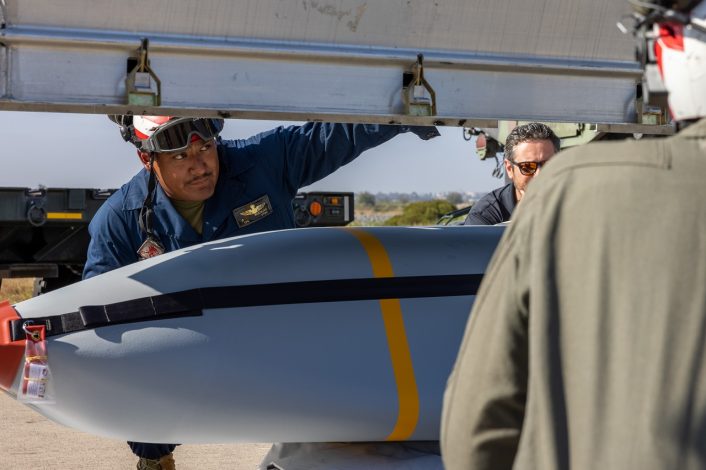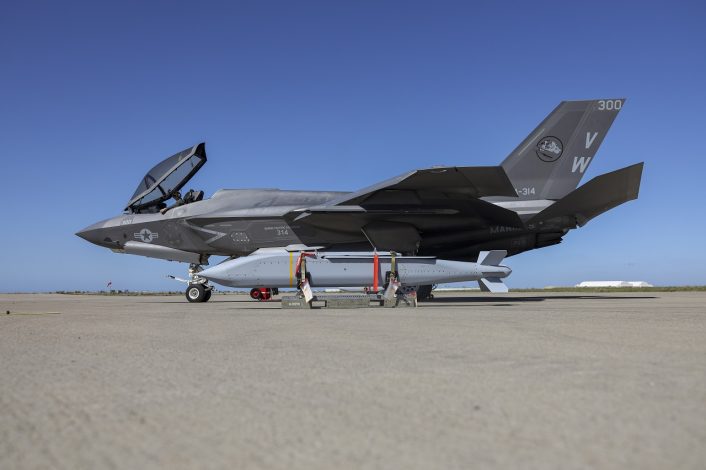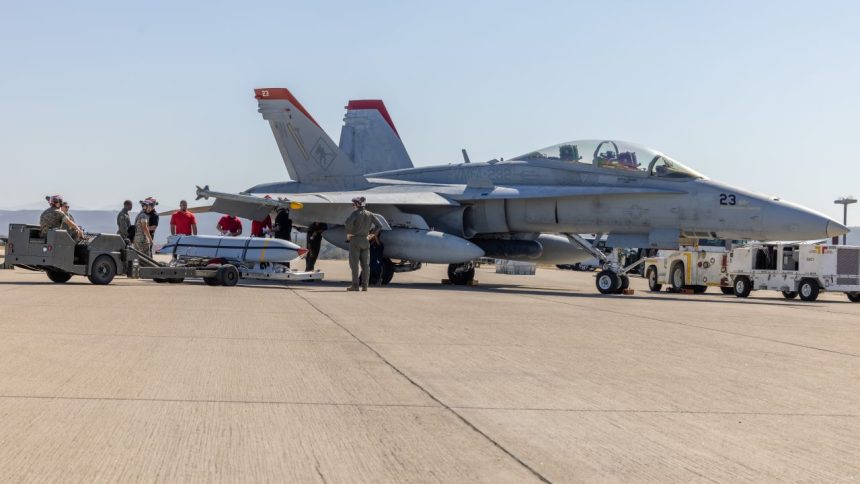The JASSM validation and verification process on the F/A-18 allowed Marines to generate feedback which will inform the development of checklists to be used by both the Marine Corps and the Navy against future adversaries.
The U.S. Marine Corps’s Marine Aviation Logistics Squadron 11 and VMFA 232 (Marine Fighter Attack Squadron) became the first, on Aug. 27, 2024, to conduct “ordnance operations” on their F/A-18 Hornet fighters with the AGM-158A JASSM (Joint Air-to-Surface Standoff Missile). This was during “validation and verification testing” at Marine Corps Air Station in Miramar, California.
The live JASSM – since no training rounds of the missile exist according to the Marines – was put through all the steps of operating the munition, including loading procedures, connection of hardware and software components, which the service says is a required protocol before the JASSM is incorporated in the Marine Corps arsenal.
The entire drill was reversed in the exact order, with the goal of developing the Marine Corps loading manual for the AGM-158A JASSM and “inform the development of checklists to be used by both the Marine Corps and the Navy against future adversaries.”
The statement described the JASSM as a “conventional, stealthy, air launched ground attack cruise missile with a range of 370 km (230 miles).” The U.S. employed the JASSM in combat for the first time in 2018, when it was fired from the U.S. Air Force B-1B Lancer bombers, destroying a Syrian chemical weapons manufacturer and proving the JASSM’s effectiveness.
Leading Allied strike missile
The JASSM is the mainstay of Allied air-launched standoff weapons for land strikes. On May 28, 2024, the Polish government signed a contract to procure another batch of JASSM-ER in a $735 million contract covering 821 missiles, and last year also expressed interest in the JASSM-XR.
This was followed by Finland announcing the acquisition of AGM-158B JASSM-ERs on May 31, to integrate them on the F-35As expected to be delivered by 2026. Helsinki already uses the AGM-158A JASSM, which is carried by its FA-18C/D Hornets. On Jul. 4, the Japan MoD also approved the acquisition of the AGM-158B JASSM-ER through a Foreign Military Sales (FMS) route.

The JASSM is also the weapon of choice for the USAF’s Rapid Dragon project. The program envisages both the C-130J Hercules and C-17 Globemaster III cargo aircraft packing the missiles in disposable pallets, which are released from the ramps and subsequently eject the missiles. The service tested this palletized missile release on various occasions, including during an exercise in the western Pacific in July 2023.
The JASSM has several variants, including the baseline AGM-158A JASSM that is no longer in production. The AGM-158B JASSM-ER is the baseline of the extended range version. The AGM-158B-2 JASSM-ER and the AGM-158B-3 JASSM-ER have different and upgraded electronic circuitry, guidance, navigation and seeker systems.
According to The War Zone, the AGM-158D JASSM-ER has a WDL (Weapon Data Link) capability that allows retargeting/retasking the missile mid-flight. The capability was mentioned in the Air Force’s Fiscal Year 2025 budget documentation and is still under-development. Meanwhile, the AGM-158C LRASM (Long-Range Anti-Ship Missile) is a derivative of the land-strike munition.
The missiles can be fired from all airborne U.S. platforms, including Navy F/A-18 Super Hornets, and Air Force F-16s, F-15s, F-35s (externally), B-1B Lancer, the B-2 Spirit and the B-52H Stratofortress strategic bombers.
1/ “The XR is being designed as the next version of the JASSM-D and LRASM-C3 … Jon Hill, vice president and general manager of air dominance and strike weapons at Lockheed Martin Missiles and Fire Control, told reporters.”https://t.co/j2aIS499SS pic.twitter.com/8fxvRr7ZRh
— Guy Plopsky (@GuyPlopsky) September 16, 2024
Marine Corps Integration
The U.S.M.C. statement quoted aviation ordnance officer Maj. Bradley Kirby from the 3rd Marine Wing, who said the AGM-158A’s integration into the F/A-18’s arsenal “significantly enhances the Hornet’s capabilities, enabling it to strike targets from well beyond the reach of enemy air defenses.”
“Marines conducted validation and verification testing by loading an AGM-158A JASSM onto an F/A-18 assigned to VMFA-232 to evaluate the loading procedures, connecting hardware and software – a required protocol before the JASSM is incorporated in the Marine Corps arsenal,” said the press release. “The validation and verification process requires attention to detail and technical qualifications maintained by the MALS-11 and VMFA-232 aviation ordnance technicians.”
MALS-11 Marines unboxed, inspected, and prepared the JASSM for transfer to VMFA-232 at the MCAS Miramar combat aircraft loading area, explained the service. Marines with VMFA-232 then inspected the weapon before initiating the aircraft loading sequence and post-loading checks. The post-loading checks were performed while the F/A-18 was powered-on to ensure communication between the aircraft and the missile.
The DOD just announced a $130 million contract for Lockheed Martin to increase JASSM and LRASM missile production.
This comes hours after Politico reported that the US is “open” to supplying Ukraine with JASSM air launched cruise missiles. https://t.co/RdUVaPgz2E pic.twitter.com/rp4fXMVrjm
— OSINTtechnical (@Osinttechnical) August 15, 2024
Upon loading, they “reversed the process, incorporating modifications and annotations into the final instructions,” which will inform the Marine Loading manual for the AGM-158A JASSM. “The JASSM validation and verification process allowed Marines to generate feedback that will inform the development of checklists to be used by both the Marine Corps and the Navy against future adversaries,” said VMFA-232’s ordnance officer, Warrant Officer Josiah Hood.
But what distinguished the drill was the AGM-158A was a “live” weapon, and not a training round, owing to the absence of JASSM training missiles. Usually, a training missile is used for validation and verification tests. This saves any accidental mishandling-related incidents or damage to the missile during training and handling.
Marine Corps strike fighter platforms are postured to acquire long-range, maritime strike capabilities with the inclusion of the AGM-158B joint air-to-surface standoff missile extended range and AGM-158C long range anti-ship missile on the F-35B/C weapons integration roadmap.

Not the only stand-off weapon
The F/A-18s of the Marines also have another stand-off weapon in their inventory, although with a smaller range: the AGM-154 Joint Standoff Weapon (JSOW) glide bomb, with a range of 70 miles. The legacy Hornet is in fact cleared to use older variants of the weapon, while talks in the past about integrating the newer AGM-154C did not materialize.
Earlier this year, on Mar. 8, 2024, the USMC loaded the AGM-154C on an F-35C of Marine Fighter Attack Squadron (VMFA) 314 at MCAS Miramar. The service said this was the first loading of the weapon system on the F-35C and the first time being loaded in a garrison environment in nearly 20 years.
The AGM-154C-1 is a bunker-buster weapon that can punch through hardened structures thanks to its BROACH (British Royal Augmentation Charge) warhead. The warhead, which is the same type also used by the Storm Shadow/SCALP air-launched cruise missile, is developed by BAE Systems.
A difference which immediately identified the JSOW-C is the presence of the Imaging Infrared (IIR) terminal seeker in the nose of the weapon, which adds to the already present GPS/INS guidance of the earlier variants. A notable aspect is that JSOW, contrary to the JASSM, can be carried internally by the F-35C.









